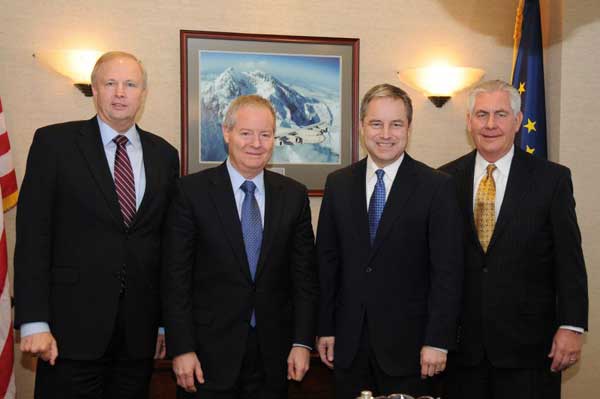Alaska Governor Governor Sean Parnell met with the chief executive officers from BP, ConocoPhillips and Exxon Mobil on January 5, 2012, to discuss alignment between the three companies on commercializing the North Slope’s vast natural gas reserves.
A news release from the governor’s office says Parnell asked “the three companies – the major lease holders for natural gas reserves on the North Slope – to work together on developing a liquefied natural gas (LNG) project that focuses on exporting Alaska North Slope gas to Asia’s growing markets.”
The release says that governor is targeting LNG exports to Asia to serve the growing demand for natural gas. That would make an Alaska LNG export terminal a rival to the three projects at Kitimat and another proposed project in Oregon.
Parnell and the CEOs – Bob Dudley of BP, Jim Mulva of ConocoPhillips and Rex Tillerson of Exxon Mobil – met for two hours. During the meeting, the governor’s release says, the CEOs briefed the governor on the extensive work they’ve been doing in response to his request. After meeting with the governor, the three CEOs briefed members of the Alaska state legislature.

“I appreciate the willingness of the chief executives to come to Alaska to discuss the important topic of commercializing North Slope gas,” Parnell said. “For a gas project to advance, all three companies need to be aligned behind it. This meeting is an important step, but much work remains.”
The Associated Press reports that Parnell wants the companies to unite under the framework of the Alaska Gasline Inducement Act, which gave TransCanada Corp. an exclusive state license to build a pipeline and up to $500 million in state incentives.
AP says TransCanada has been working with Exxon Mobil to advance the project but has yet to announce any agreements with potential shippers.
TransCanada has focused most of its attention on a pipeline that would deliver gas to North American markets through Alberta to Canada and the Lower 48 states. TransCanada has also proposed a smaller pipeline that would allow for liquefied natural gas exports through a terminal at the oil export port of Valdez. A rival project, a joint effort of BP and ConocoPhillips that also would have gone through Canada, folded last year.
The Alaska Journal of Commerce reports BP and ConocoPhillips believe a major liquefied natural gas project is the best option for marketing North Slope gas, quoting the chief executive officers of the two companies Robert Dudley of BP and James Mulva of ConocoPhillips.
“Given the outlook with shale gas in the Lower 48, it looks like LNG has the best potential. We’re not saying the pipeline (to Canada) is impossible,” but a pipeline to southern Alaska to an LNG plant appears to have the best prospects, BP CEO Dudley told reporters following the meetings with Parnell and legislators.
ConocoPhillips’ Mulva agreed with Dudley. “We believe LNG is the best alternative for North Slope gas, far better than any alternatives,” Mulva said.